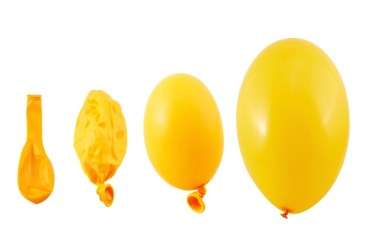Science Experiments for Kids: Bottle Balloon Blow-Up

In this article, you will find:
Observing Air Pressure
Science Experiments for Kids: Bottle Balloon Blow-Up
If your child jumps for joy at the thought of blowing things up, she will really enjoy the Bottle Balloon Blow-Up experiments. Though her excitement may die down temporarily when she realizes the only thing getting blown up is the balloon, it will be quickly reignited when she realizes that she can blow up balloons using various forces, none of which include forcing air from her lungs into the balloon. These experiments work best with latex balloons. However, before you begin, make sure none of your participants have latex allergies.
Skills Being Practiced
- Scientific inquiry
- Observation of the power of carbon dioxide gas
- Observation of the power of air pressure
Baking Soda Balloon Blow-Up Experiment
This experiment demonstrates the power of the chemical reaction created by combining baking soda and vinegar. It's powerful enough to blow up a balloon!
What You Need
- Empty water bottle
- Medium-sized balloon
- Funnel
- Vinegar
- Baking soda
Create a Hypothesis
Ask your child to predict what will happen when you combine baking soda and vinegar in a bottle. If she's ever seen a science-fair volcano, it's a good time to remind her that these are the same ingredients used in the volcano. Ask her to predict what will happen if you combine the same ingredients, but cover the top of the bottle with a balloon.
How to Play
1. Fill a clean, empty water bottle about one-third full with vinegar.
2. Place a funnel in the neck of the balloon, and hold onto it as your child pours in enough baking soda to fill the balloon about halfway.
3. Slip the funnel out of the neck of the balloon. Ask your child to hold the portion of the balloon with the baking soda in it to the side and downward as you stretch the neck of the balloon up over the neck of the bottle, being careful to not let any of the baking soda slip into the bottle. Make sure it is secure.
4. Help your child slowly lift the balloon over the bottle, and let the baking soda pour inside.
5. Ask your child to move aside. Have her listen and watch the bottle carefully. As you begin to hear the fizzing and crackling noise the baking soda and vinegar solution makes, hold tight to the neck of the balloon.
6. Watch as the balloon begins to inflate!
What's Going On
When the baking soda and vinegar are combined, the acetic acid in the vinegar breaks down the chemical composition of the baking soda (calcium carbonate). The carbon combines with some of the oxygen in the bottle to create carbon dioxide gas, which then rises and inflates the balloon.